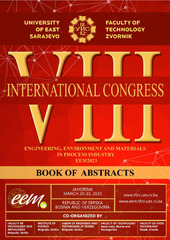Приказ основних података о документу
Investigation of Corrosion Behavior by Electrochemical Impedance Spectroscopy of Al Alloys in Al-Mg Systems
| dc.creator | Šćepanović, Jelena | |
| dc.creator | Radonjić, Dragan | |
| dc.creator | Vuksanović, Darko | |
| dc.creator | Pantović Pavlović, Marijana | |
| dc.creator | Pavlović, Miroslav | |
| dc.date.accessioned | 2023-09-08T12:57:49Z | |
| dc.date.available | 2023-09-08T12:57:49Z | |
| dc.date.issued | 2023 | |
| dc.identifier.isbn | 978-99955-81-44-2 | |
| dc.identifier.uri | https://cer.ihtm.bg.ac.rs/handle/123456789/6562 | |
| dc.description.abstract | From the aspect of corrosion stability, aluminum alloys can be divided into corrosion stable and corrosion unstable alloys. However, it should be emphasized that the corrosion properties themselves are not the only relevant factor for their use, because the use is also influenced by mechanical characteristics. In general, these properties are greatly influenced by the chemical composition, which affects the structure, and the main factor that influences the corrosion stability is presence and concentration of alloying elements. The aim of this work was to show the corrosion characteristics of alloys of the Al-Mg system, which is a continuation of previous work of the authors that was conducted in this area. Corrosion characteristics of aluminum were examined using electrochemical impedance spectroscopy during exposure in an aqueous solution of 3 wt. % NaCl. The obtained data were analyzed by equivalent electrical circuits of different configurations with a special discussion related to the appearance and type of oxide layer that is formed due to the effect of the corrosive environment on the sample and the behavior of the samples in the corrosive environment. Equivalent circuits describe the impedance responses well, and the values of the circuit parameters correspond to the proposed model of physical-chemical changes during the corrosion process of the investigated systems. EIS data indicated considerably greater corrosion resistance aluminum with higher Mg content. The corrosion processes on Al alloys with higher Mg content are subjected to more pronounced diffusion limitations in comparison to the processes below the passive oxide film, as a consequence of the formation of a highly compact protective coating. The results show that the addition of Mg is an effective way to improve corrosion resistance for aluminum. | sr |
| dc.language.iso | en | sr |
| dc.publisher | Zvornik : Faculty of Technology | sr |
| dc.relation | info:eu-repo/grantAgreement/MESTD/inst-2020/200026/RS// | sr |
| dc.rights | openAccess | sr |
| dc.rights.uri | https://creativecommons.org/licenses/by/4.0/ | |
| dc.source | Book of Abstracts - VIII International Congress Engineering, Environment and Materials in Process Industry, March 20-23, Jahorina, Republic of Srpska, Bosnia and Herzegovina | sr |
| dc.subject | aluminum alloys | sr |
| dc.subject | corrosion behavior | sr |
| dc.subject | chemical composition | sr |
| dc.subject | mechanical properties | sr |
| dc.subject | electrochemical impedance spectroscopy | sr |
| dc.subject | equivalent circuit | sr |
| dc.title | Investigation of Corrosion Behavior by Electrochemical Impedance Spectroscopy of Al Alloys in Al-Mg Systems | sr |
| dc.type | conferenceObject | sr |
| dc.rights.license | BY | sr |
| dc.citation.spage | 224 | |
| dc.citation.epage | 224 | |
| dc.citation.rank | M34 | |
| dc.identifier.rcub | https://hdl.handle.net/21.15107/rcub_cer_6562 | |
| dc.identifier.fulltext | http://cer.ihtm.bg.ac.rs/bitstream/id/26791/M34-9.pdf | |
| dc.type.version | publishedVersion | sr |


